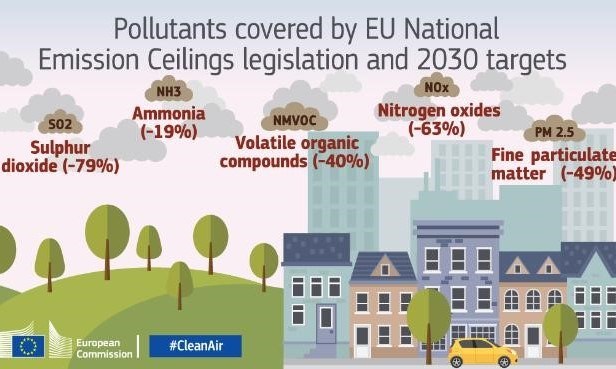While air pollution decreased temporarily during the lockdowns, most EU member states are at risk of not complying with commitments on reducing air pollution, according to a first assessment by the European Commission of the implementation of the European clean air programme.
The rules in the National Emission Reduction Commitments Directive entered into force in December 2016 and sets commitments for each member state for 2020 - 2029 and the period beyond 2030. The aim is to reduce the health impacts of air pollution by half by 2030 compared to 2005.
Member states are obliged to report every two years about their projected emissions. The first Commission assessment was published last week (26 June) and is based on the reporting that the member states were supposed to submit to the Commission by April 2019.
In fact, only 8 member states delivered their National Air Pollution Control Programmes (NAPCP) on time. A further 16 member states submitted their final NAPCPs by May 2020. The Commission initiated infringement procedures in February 2020 against three member states that had not submitted any NAPCP at the time. The reports from Greece and Romania are still missing.
With existing measures, the assessment shows that ten member states project to fulfil all 2020 emission reduction commitments, while the number falls to only four (Croatia, Cyprus, Netherlands, Finland) when it comes to the 2030 commitments. All member states not reaching their emission reduction commitments with existing measures need to put in place additional measures.
The directive targets five air pollutants responsible for significant negative impacts on human health and the environment: sulphur dioxide (SO2), nitrogen oxides (NOx), non-methane volatile organic compounds (NMVOC), ammonia (NH3) and fine particulate matter (PM2.5).

Credit: EU
For both “With Existing Measures” and “With Additional Measures” scenarios, non-compliance is most frequently projected for NH3 emission reduction commitments in agriculture, followed by NMVOC, NOx and PM2.5.
Links between air and climate/energy policies are multiple, as emitting sources of greenhouse gases and air pollutants are often the same. Methane, although being a pollutant in the agriculture and waste sectors both from clean air and climate perspectives, was not covered by the directive.
The Commission, however, is of the opinion that methane emissions should be kept under review with the aim to limit their contribution to ozone concentrations in the EU and to reduce methane emissions internationally.
Judging by the assessment, member states need to step up efforts across all sectors to make sure their citizens can breathe clean air.
“We need more effective measures to cut pollution in numerous member states and to tackle air emissions across sectors, including agriculture, transport and energy,” said Virginijus Sinkevicius, environment commissioner (26 June).
“There has never been a better time to make these changes: investing in cleaner air means investing in citizens' health, in our climate, and it's the kick-start our economy needs.”
According to a report by the European Environment Agency (EEA) in March, air pollution decreased significantly in Europe from the very start of the lockdowns during the coronavirus crisis. Nitrogen dioxide (NO2) levels, for example, were halved in some areas, mainly due to a drastic reduction in traffic. For many, this was a call to continue keeping air pollution at a low level also after the crisis.
Poor air quality is the number one environmental cause of premature death in the EU, with over 390 000 premature deaths every year, according to the Commission. It also impacts on the quality of life, by causing or exacerbating asthma and respiratory problems, and damages ecosystems through excess nitrogen pollution and acid rain.
M. Apelblat
The Brussels Times

